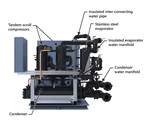Process Cooling: Applying Expended Energy for Useful Plant Operations
Centralized cooling system uses a heat pump to recover cooling fluid energy and repurpose it for everything from pre-heating plastic prior to processing; to heating offices, storage areas, assembly rooms; to regenerating desiccant for dehumidification.
Share
Plastic Systems USA’s Blauwer Division says its Air Chillers represent a cost-effective alternative to cooling towers, with the added benefit of energy recovery. Heat pumps transfer heat energy from a heat source to a thermal reservoir and then move that thermal energy in the opposite direction of spontaneous heat transfer, by absorbing heat from a cold space and releasing it to a warmer one.
The heat pump uses external power to transfer energy from the heat source to the heat sink. In the most common design, heat pumps have four main components—a condenser, an expansion valve, an evaporator and a compressor. The heat-transfer medium circulated through these components is a refrigerant.
In Blauwer’s process, a portion of the 59 F process return water is delivered to a heat pump, which removes energy from the water and transfers it to heat air, raising the temperature up to 212 F. This air is then used to regenerate the desiccant wheel for a centralized air-dehumidifying system, which prevents humidity condensation on mold surfaces. While using the energy coming from the return chilled water and transferring it to heat-up air, the water is cooled to 54 F. Plastics Systems says energy savings can range up to 75% compared to traditional air-dehumidifying systems.
In a Low Temperature Circuit (LTC) for for mold cooling, the processing cooling fluid might have a temperature range between 46 and 77 F. Blauwer notes that it is important to ensure optimal flow through the chillers to optimize heat exchange and automatically regulate the water flowing to the process according to need by the use of an inverter on pumps. In addition, “free” cooling when ambient conditions allow can save more energy.
By integrating one control that can rotate through different chiller compressors to equalize the workload, and shutting off one or more chillers when they’re not required based on process load, the system can save even more energy.

Blauwer’s Air Chiller recovers energy from the cooling process and repurposes it throughout a plant.
Related Content
-
Captive Molder Beefs Up Auxiliaries to Boost Quality, Consistency
SeeScan adds conveying, drying, feeding and chilling technologies to improve quality — and enhance employee safety — in production of its underground/underwater inspection systems.
-
Low Temperature Portable Chiller Product Line Expanded
Mokon now offers the Iceman low-temperature line of portable chillers with dual-circuit capacity control.
-
Hot Oil Temperature Control Units Expand Heating Capacity and Flow Rates
Thermal Care’s Oiltherm hot-oil temperature control units (TCUs) extend heating capacities up to 90 kW and flow capabilities up to 50 gpm.







